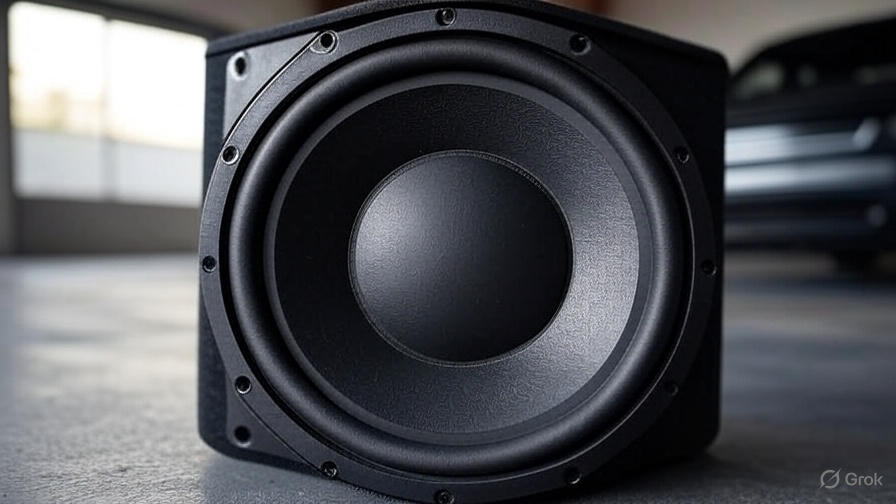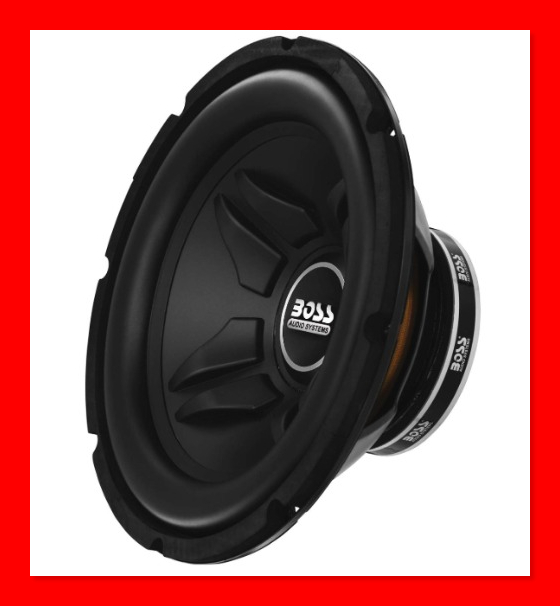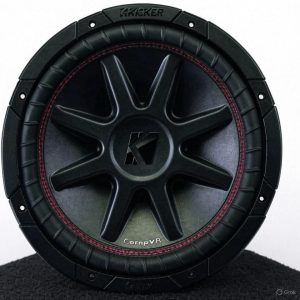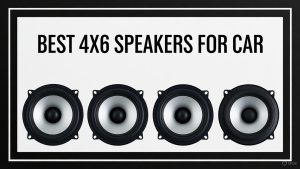Transform your driving experience with the thunderous power of premium 12-inch car subwoofers. These powerhouse drivers deliver the deep bass frequencies that make your favorite music come alive while cruising down the highway. Car audio enthusiasts recognize 12-inch subwoofers as the sweet spot between compact efficiency and earth-shaking low-end response.
The market offers numerous options for drivers seeking that perfect bass experience. Five standout models consistently earn praise from both professional installers and everyday music lovers. Each subwoofer brings unique strengths to the table, catering to different budgets, installation requirements, and sound preferences.
Why 12-Inch Subwoofers Rule the Road
12-inch subwoofers occupy a unique position in car audio systems. They strike an optimal balance between physical size constraints and acoustic performance. Smaller drivers struggle to move enough air for truly impactful bass, while larger units often demand excessive trunk space and electrical power.
The physics behind subwoofer performance favors the 12-inch diameter. These drivers can reproduce frequencies as low as 20Hz while maintaining reasonable efficiency ratings. This efficiency translates to more bass output per watt of amplifier power, making them practical for most vehicle electrical systems.
Installation flexibility sets 12-inch subs apart from their larger counterparts. Most sedan trunks, SUV cargo areas, and truck cabs accommodate properly designed enclosures for these drivers. This versatility explains why aftermarket audio shops stock more 12-inch options than any other subwoofer size.
Power handling capabilities of modern 12-inch subwoofers satisfy both casual listeners and competition enthusiasts. Entry-level models handle 300-500 watts RMS, while high-performance versions accept 1000+ watts without distortion. This range covers everything from factory radio upgrades to full competition systems.
1. Pioneer TS-A301D4: Championship Performance at Budget Prices
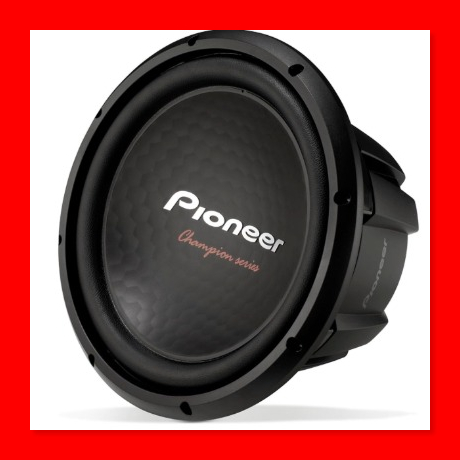
Pioneer’s Champion Series TS-A301D4 delivers exceptional value with its 1600-watt peak power handling and dual 4-ohm voice coil configuration. This subwoofer represents decades of Pioneer’s engineering expertise condensed into an affordable package that doesn’t sacrifice performance for price.
The redesigned motor assembly forms the heart of the TS-A301D4’s impressive performance. Pioneer engineers increased the magnet structure size and optimized the voice coil gap for improved efficiency. This translates to louder bass output from the same amplifier power compared to previous generations.
Build quality exceeds expectations for a budget-oriented subwoofer. The polypropylene cone construction provides excellent durability while maintaining proper flexibility for accurate bass reproduction. The rubber surround seals the cone edges without adding unwanted resonances that muddy the sound.
Installation proves straightforward thanks to the dual voice coil design. This configuration offers wiring flexibility for different amplifier setups. Connect the coils in parallel for 2-ohm operation or series for 8-ohm impedance, depending on your amplifier’s capabilities.
The TS-A301D4 performs best in sealed enclosures between 1.0 and 1.5 cubic feet. This relatively compact box requirement makes it suitable for vehicles with limited cargo space. The subwoofer also works well in ported enclosures tuned around 32Hz for maximum output.
Sound characteristics lean toward punchy, controlled bass rather than earth-shaking low-end extension. Music genres like rock, pop, and electronic dance music benefit from this tuning approach. The subwoofer reproduces kick drums and bass lines with excellent definition and impact.
Power handling stays conservative at 500 watts RMS, making it perfect for mid-range amplifiers. The 1600-watt peak rating handles brief musical transients without damage. This power specification suits most aftermarket head units and amplifier combinations.
Value proposition makes the TS-A301D4 hard to beat in its price category. Pioneer’s reputation for reliability combines with solid performance specifications to create a compelling option for first-time subwoofer buyers or budget-conscious upgraders.
2. CT Sounds Hydro 12″: Shallow Mount Innovation
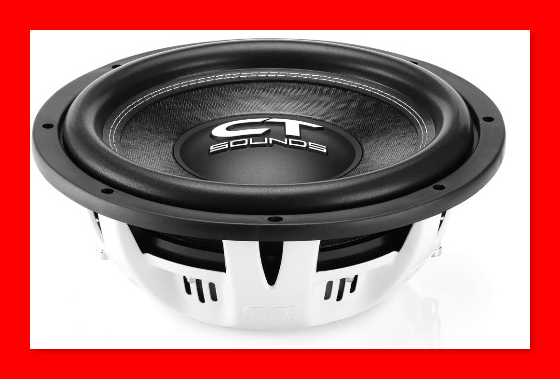
CT Sounds revolutionizes space-constrained installations with their Hydro 12-inch shallow mount subwoofer. This innovative design delivers full-range bass performance while requiring minimal mounting depth, solving installation challenges in modern vehicles with limited cargo space.
The shallow mount design compresses the motor assembly height without compromising magnetic strength. CT Sounds achieves this through advanced magnet materials and optimized voice coil positioning. The result is a subwoofer that fits spaces where traditional drivers simply won’t work.
Dual 2-ohm voice coils provide excellent amplifier matching flexibility. Wire them in parallel for 1-ohm loads that maximize power from competition amplifiers, or series for 4-ohm operation with standard car audio amps. This versatility accommodates various system configurations.
Construction quality reflects CT Sounds’ commitment to performance and durability. The cast aluminum frame provides exceptional rigidity while dissipating heat effectively. Heat management becomes critical in shallow mount designs where air circulation is often restricted.
The specially designed cone combines lightweight materials with reinforced construction. This balance allows rapid movement for transient response while maintaining structural integrity under high power conditions. The cone’s geometry optimizes air displacement despite the shallow profile.
Installation depth measures just 3.5 inches from mounting surface to rear of magnet. This compact profile opens installation possibilities in trucks with tool boxes, SUVs with spare tire wells, and sedans with trunk-mounted amplifiers. Many vehicles that couldn’t accommodate traditional subwoofers become viable candidates.
Enclosure requirements remain reasonable despite the shallow design. Sealed boxes between 0.8 and 1.2 cubic feet work well, while ported enclosures tuned around 35Hz maximize output. The subwoofer adapts to various box designs without dramatic performance changes.
1000-watt peak power handling puts the Hydro in serious performance territory. The 350-watt RMS rating handles most aftermarket amplifiers without strain. This power specification supports everything from moderate volume listening to party-level output.
Sound signature emphasizes tight, controlled bass with excellent transient response. The shallow mount design actually benefits sound quality by reducing cone excursion requirements. Less cone movement means lower distortion and more accurate bass reproduction.
Price positioning makes the CT Sounds Hydro competitive with traditional depth subwoofers while offering unique installation advantages. The shallow mount premium is minimal compared to the installation flexibility gained.
3. MTX Terminator Series: Complete System Solution
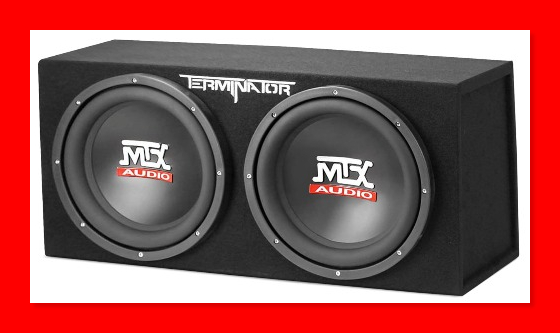
MTX removes installation complexity with their Terminator dual 12-inch loaded enclosure system. This complete package includes matched subwoofers, optimized enclosure, and all necessary wiring for plug-and-play installation. The approach appeals to drivers seeking maximum convenience without sacrificing performance.
Terminator speakers combine high quality construction and excellent performance with economic value. The dual 12-inch configuration provides substantial air displacement for impressive bass output while maintaining reasonable amplifier requirements.
Enclosure design reflects decades of MTX acoustic engineering experience. The ported design optimizes tuning frequency for maximum efficiency around 32Hz. This tuning produces strong output in the frequencies where most music contains its bass content.
Subwoofer specifications include 600 watts RMS total power handling and 1200 watts peak. This rating supports powerful amplifiers while staying within reach of most car audio budgets. The 400-watt RMS per driver splits the load evenly between the matched pair.
Build materials emphasize durability and acoustic performance. The MDF enclosure construction provides excellent internal bracing and resonance control. Carpet covering protects the finish while adding professional appearance that complements vehicle interiors.
Dual subwoofer benefits extend beyond simple volume increases. Two drivers sharing the workload operate with less stress than a single subwoofer handling the same power. This reduced stress improves reliability and extends operational life under demanding conditions.
Installation simplicity ranks among the system’s greatest advantages. The complete package eliminates enclosure building, driver matching, and acoustic tuning decisions. Connect amplifier outputs to the provided terminals and mount the enclosure securely in your vehicle.
Sound characteristics favor impact and presence over subtle nuances. The dual driver configuration and ported enclosure design create substantial output that energizes large vehicle interiors. Rock, hip-hop, and electronic music genres particularly benefit from this approach.
Space requirements demand careful consideration before purchase. The dual 12-inch enclosure occupies significant cargo area in most vehicles. Measure available space carefully and consider how the installation affects daily vehicle use.
Value analysis shows favorable cost per performance compared to purchasing separate components. The included enclosure, matched drivers, and professional tuning eliminate additional expenses while ensuring optimal results.
System compatibility works with most aftermarket amplifiers rated between 300 and 800 watts RMS. This power range covers popular car audio amplifier categories from budget-friendly to enthusiast-grade units.
4. Skar Audio SDR-12 D4: Competition-Grade Performance
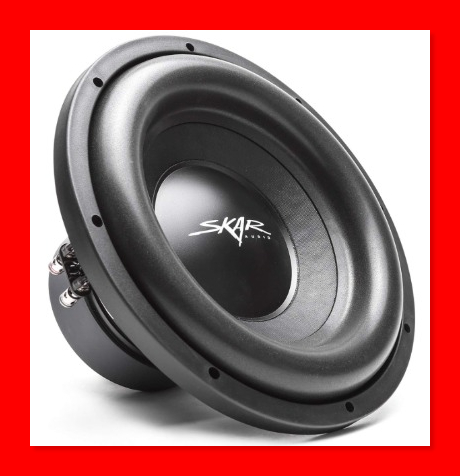
Skar Audio’s SDR-12 D4 delivers serious performance with 1200 watts peak power handling and dual 4-ohm voice coil configuration. This subwoofer targets enthusiasts seeking competition-level output without the premium pricing of exotic brands.
The motor assembly forms the foundation of the SDR-12’s impressive performance. Skar Audio engineers oversized the magnet structure and optimized the voice coil positioning for maximum efficiency. This attention to detail produces more bass output per watt than comparable budget subwoofers.
Voice coil construction utilizes high-temperature wire and former materials capable of handling extreme power levels. The dual 4-ohm configuration offers wiring flexibility for various amplifier impedance requirements. Connect coils in parallel for 2-ohm loads or series for 8-ohm operation.
Cone design balances lightweight construction with structural rigidity. The pressed paper cone material provides excellent damping characteristics while maintaining the strength needed for high-excursion operation. The cone’s geometry optimizes air displacement across the operating frequency range.
Suspension components work together to control cone movement precisely. The treated foam surround allows maximum excursion without roll-off, while the progressive spider maintains linear operation through the full travel range. This combination prevents mechanical damage during extreme operation.
Enclosure recommendations vary depending on desired sound characteristics. Sealed boxes between 1.2 and 1.8 cubic feet produce tight, accurate bass perfect for rock and acoustic music. Ported enclosures tuned around 30Hz maximize output for electronic and hip-hop genres.
Power handling specifications support serious amplification. The 600-watt RMS rating handles most aftermarket amplifiers without strain, while the 1200-watt peak specification accommodates brief musical transients. This headroom prevents thermal or mechanical damage during demanding passages.
Sound quality surpasses expectations for an aggressively priced subwoofer. The SDR-12 produces clean, undistorted bass with excellent definition and impact. Frequency response extends smoothly from 25Hz to 500Hz without significant peaks or valleys.
Installation requirements include robust mounting and adequate electrical supply. The subwoofer’s performance potential demands secure enclosure mounting and sufficient amplifier power supply. Skimping on installation quality undermines the driver’s capabilities.
Competition credentials come from real-world testing in SPL competitions. Many enthusiasts choose multiple SDR-12 drivers for systems targeting 140+ dB output levels. The subwoofer’s reliability under extreme conditions validates its performance specifications.
Price-to-performance ratio establishes the SDR-12 as a standout value in its category. Competing subwoofers with similar specifications often cost significantly more while delivering comparable or inferior results.
5. BOSS Audio CXX12: Reliable Budget Option
BOSS Audio’s CXX12 targets budget-conscious buyers seeking reliable bass enhancement without premium pricing. This single 4-ohm subwoofer provides solid performance for factory radio upgrades and entry-level aftermarket systems.
The 1000-watt maximum power specification provides adequate headroom for most applications. The 350-watt RMS rating matches well with affordable amplifiers in the 200-400 watt category. This power level suits moderate listening volumes and casual music enjoyment.
Construction emphasizes durability and value over exotic materials. The polypropylene cone provides good damping characteristics while resisting environmental damage. The rubber surround seals effectively without adding unwanted resonances to the frequency response.
Motor design uses traditional ferrite magnets in a proven configuration. While not as exotic as neodymium alternatives, ferrite magnets provide reliable performance and consistent magnetic field strength over time. The voice coil uses aluminum wire for good conductivity and heat dissipation.
Enclosure compatibility covers both sealed and ported designs. Sealed boxes between 1.0 and 1.5 cubic feet work well for tight, controlled bass. Ported enclosures tuned around 35Hz increase output at the cost of some accuracy. The subwoofer adapts to various box designs without dramatic performance changes.
Installation proves straightforward with standard mounting practices. The subwoofer’s moderate power requirements don’t demand extensive electrical upgrades or exotic amplifiers. Most aftermarket head units provide sufficient signal for proper operation.
Sound characteristics emphasize quantity over ultimate quality. The CXX12 produces substantial bass output that enhances music enjoyment without critical listening scrutiny. This approach suits drivers seeking impressive bass impact rather than audiophile-grade accuracy.
Reliability comes from BOSS Audio’s simplified design approach. Fewer exotic materials and conservative specifications typically translate to longer operational life and fewer field failures. This reliability factor appeals to buyers seeking worry-free performance.
Value proposition targets first-time subwoofer buyers and budget system builders. The CXX12 provides significant bass improvement over factory audio systems at minimal cost. This combination makes it an excellent introduction to aftermarket car audio.
Limitations include reduced output compared to higher-end competitors and less sophisticated frequency response. These compromises are reasonable given the aggressive pricing and target market positioning.
Essential Buying Considerations
Power Requirements and Amplifier Matching
Subwoofer power handling determines amplifier requirements and system cost. Match RMS power ratings between subwoofers and amplifiers for optimal performance. Peak power ratings provide marketing appeal but don’t guide real-world amplifier selection.
Impedance matching affects both power delivery and system efficiency. Dual voice coil subwoofers offer wiring flexibility that single coil models cannot match. This flexibility becomes valuable when adding multiple subwoofers or matching specific amplifier impedance requirements.
Electrical system capacity limits maximum subwoofer power in many vehicles. Factory alternators and wiring often restrict amplifier size regardless of subwoofer capabilities. Consider electrical upgrades when planning high-power installations.
Enclosure Design Impact
Subwoofer enclosures dramatically affect sound quality and output characteristics. Sealed enclosures provide tight, accurate bass with excellent transient response. Ported enclosures increase output at specific frequencies while requiring more space and careful tuning.
Volume requirements vary significantly between subwoofer models. Some drivers work well in compact enclosures under 1.0 cubic feet, while others demand 2.0+ cubic feet for optimal performance. Match enclosure space availability with subwoofer specifications.
Build quality affects both sound and longevity. MDF construction provides better acoustic properties than particle board or plastic alternatives. Internal bracing reduces enclosure resonances that color the sound. Quality hardware ensures secure mounting and professional appearance.
Installation Space Planning
Vehicle interior space determines practical subwoofer size limits. Measure available installation areas carefully before purchasing subwoofers. Consider how enclosure placement affects cargo capacity and passenger comfort.
Mounting security becomes critical with powerful subwoofers. Unsecured enclosures become dangerous projectiles during accidents or emergency stops. Use appropriate mounting hardware and distribute loads across vehicle structure points.
Wiring accessibility influences installation complexity and cost. Plan amplifier locations, power wire routing, and signal cable paths before beginning installation. Hidden wire routing creates cleaner installations but may require professional assistance.
Sound Quality vs Output Tradeoffs
Musical preferences should guide subwoofer selection decisions. Jazz, classical, and acoustic music benefit from accurate, controlled bass response. Electronic, hip-hop, and rock genres often favor maximum output over ultimate accuracy.
Room acoustics affect subwoofer performance in vehicle environments. Hard surfaces reflect bass energy while soft materials absorb it. Consider interior materials when planning system tuning and enclosure placement.
Listening volume habits determine power requirements and driver capabilities. Moderate volume listeners can achieve satisfaction with less powerful subwoofers, while party-level output demands serious power handling and amplifier capacity.
Technical Specifications Breakdown
Voice Coil Configurations
Single voice coil subwoofers offer simplicity and lower cost but limit wiring options. Dual voice coil designs provide installation flexibility at slightly higher prices. The ability to wire coils in parallel or series doubles impedance options for better amplifier matching.
Voice coil materials affect power handling and heat dissipation. Aluminum voice coils conduct heat well but cost less than copper alternatives. Copper coils offer better electrical conductivity but require more sophisticated manufacturing processes.
Suspension Components
Surround materials determine excursion limits and longevity. Rubber surrounds provide excellent durability but may limit maximum movement. Foam surrounds allow greater excursion but deteriorate faster in extreme conditions. Modern synthetic materials attempt to combine the best characteristics of both.
Spider design controls voice coil alignment and provides restoring force for cone movement. Progressive spiders increase stiffness as excursion increases, providing protection against over-excursion damage. Linear spiders maintain constant force throughout the travel range for more accurate reproduction.
Magnet Assembly Design
Ferrite magnets provide reliable performance at reasonable cost but require larger assemblies for equivalent magnetic field strength. Neodymium magnets create stronger fields in smaller packages but cost significantly more. Most budget and mid-range subwoofers use ferrite magnet systems.
Magnet ventilation affects power handling and reliability. Vented pole pieces allow air circulation through the voice coil gap, reducing operating temperatures. This cooling improves power handling and extends voice coil life under demanding conditions.
Installation Best Practices
Enclosure Construction Guidelines
Proper enclosure construction maximizes subwoofer performance while ensuring long-term reliability. Use minimum 3/4-inch MDF for all panels, with thicker material for high-output applications. Internal bracing prevents panel resonances that color sound quality.
Joint sealing prevents air leaks that reduce system efficiency. Apply wood glue to all joints and use appropriate fasteners for secure assembly. Test enclosures for air leaks before final installation using low-frequency test tones.
Amplifier Integration
Amplifier location affects both performance and installation complexity. Mount amplifiers in well-ventilated areas away from heat sources. Trunk installations often provide better cooling than under-seat locations but require longer wire runs.
Gain adjustment determines system balance and prevents amplifier clipping. Set gains using test tones and oscilloscope measurement when possible. Improper gain settings cause amplifier failure and subwoofer damage more than any other factor.
Crossover frequency selection optimizes integration with existing speakers. Most installations benefit from crossover points between 80Hz and 120Hz. Higher settings may overlap with door speakers, while lower settings can create gaps in frequency response.
Electrical System Considerations
Power wire gauge must match amplifier current requirements to prevent voltage drop and fire hazards. Use manufacturer recommendations as minimum requirements, not suggestions. Longer wire runs require larger gauge sizes to maintain proper voltage delivery.
Fusing protects both amplifiers and vehicle electrical systems from damage. Install fuses as close to the battery as possible, typically within 18 inches of the positive terminal. Use appropriate fuse ratings based on amplifier specifications and wire gauge.
Grounding quality affects both performance and safety. Connect ground wires directly to vehicle chassis or engine block using clean, tight connections. Poor grounding causes noise, reduced power output, and potential safety hazards.
Sound Tuning and Optimization
Phase Adjustment Impact
Subwoofer phase alignment with main speakers affects overall system integration. Incorrect phase settings create cancellation effects that reduce bass output and muddy sound quality. Use test tones and careful listening to optimize phase relationships.
Physical positioning influences phase relationships between subwoofers and main speakers. Front-firing subwoofers often integrate better than rear-firing designs in sedan installations. SUV and truck installations may favor different orientations based on interior acoustics.
Equalization Strategies
Parametric equalization corrects frequency response irregularities caused by vehicle acoustics and installation compromises. Boost or cut specific frequencies to achieve desired sound balance. Avoid excessive equalization that reduces headroom or increases distortion.
Room correction systems automate equalization processes but require careful setup and calibration. These systems can dramatically improve sound quality in challenging acoustic environments. However, manual tuning often produces better results for experienced installers.
Integration with Factory Systems
Factory audio system integration presents unique challenges and opportunities. Many modern vehicles include sophisticated sound processing that affects subwoofer integration. Research factory system capabilities before planning aftermarket additions.
Signal acquisition methods vary depending on factory system design. High-level inputs work with most factory amplified systems, while low-level inputs require aftermarket head units or signal processors. Line output converters provide alternatives for complex factory integrations.
Maintenance and Longevity
Thermal Management
Heat represents the primary enemy of subwoofer longevity. Voice coils operate at elevated temperatures during normal use but can fail when temperatures exceed design limits. Adequate ventilation and appropriate power levels prevent thermal damage.
Duty cycle awareness helps prevent overheating during extended listening sessions. Allow subwoofers to cool between high-volume periods. Competition-level output should be limited to brief demonstrations rather than continuous operation.
Mechanical Wear Factors
Suspension components experience wear over time, particularly in high-excursion applications. Surrounds and spiders gradually lose elasticity, affecting performance and reliability. Quality suspension materials resist wear better than budget alternatives.
Voice coil alignment changes as suspension components age. Regular inspection helps identify problems before catastrophic failure occurs. Replace worn suspension components promptly to maintain performance and prevent further damage.
Environmental Protection
Moisture represents a significant threat to subwoofer components. Condensation can damage voice coils, while direct water exposure causes immediate failure. Ensure proper enclosure sealing and avoid installations in areas prone to water intrusion.
Temperature extremes affect subwoofer materials differently. Cold temperatures make suspension components stiff and brittle, while excessive heat accelerates material degradation. Park in shaded areas when possible and allow systems to warm up gradually in cold weather.
Performance Optimization Tips
Break-In Procedures
New subwoofers benefit from gradual break-in procedures that allow suspension components to reach optimal flexibility. Play moderate volume levels for the first 20-30 hours of operation. This gradual process improves performance and extends operational life.
Mechanical break-in affects both frequency response and power handling. Suspension components become more compliant over time, typically extending low-frequency response and increasing maximum excursion capabilities. The process occurs naturally during normal use.
System Calibration Methods
Real-time analyzer measurements provide objective data for system optimization. Measure frequency response at the listening position and adjust equalization accordingly. This scientific approach often reveals problems that aren’t obvious during casual listening.
Listening tests complement measurement data with subjective evaluation. Use familiar music selections that showcase various bass instruments and frequencies. Switch between different settings while listening to determine optimal configurations.
Common Installation Mistakes
Amplifier clipping causes more subwoofer failures than any other factor. Learn to recognize clipping symptoms and adjust gain settings appropriately. Distorted bass indicates potential amplifier problems that require immediate attention.
Inadequate enclosure volume reduces subwoofer performance and may cause mechanical damage. Follow manufacturer specifications for minimum and maximum enclosure volumes. When in doubt, choose larger enclosures rather than smaller alternatives.
Poor wire connections create resistance that reduces power delivery and generates heat. Use proper connectors and ensure tight connections throughout the signal chain. Inspect connections periodically and clean corrosion promptly.
Cost vs Performance Analysis
Budget Category Performance
Entry-level 12-inch subwoofers provide substantial improvement over factory audio systems at reasonable cost. Expect basic construction, moderate power handling, and simplified voice coil configurations. These limitations are acceptable for casual listening and moderate volume levels.
Installation costs often exceed subwoofer prices in budget categories. Professional installation ensures proper integration and optimal performance but adds significantly to total system cost. DIY installation reduces costs but requires tools, skills, and time investment.
Mid-Range Value Propositions
Mid-range subwoofers offer improved materials, better construction, and higher power handling compared to budget alternatives. The performance increase justifies higher prices for serious music listeners and moderate enthusiasts.
Feature sets expand in mid-range categories to include dual voice coils, improved suspension components, and better magnetic assemblies. These features provide installation flexibility and improved sound quality that budget models cannot match.
Premium Category Benefits
High-end 12-inch subwoofers justify premium pricing through exotic materials, advanced engineering, and exceptional build quality. These subwoofers target audiophiles and competition enthusiasts who demand maximum performance regardless of cost.
Manufacturing precision reaches levels impossible at lower price points. Tighter tolerances, better quality control, and premium materials combine to create subwoofers that perform consistently at their design limits.
Installation Environment Considerations
Sedan Trunk Installations
Sedan trunk installations offer excellent acoustic isolation and security but limit cargo space. The enclosed environment helps loading and provides consistent acoustic conditions. However, access for maintenance and adjustments becomes more difficult.
Spare tire wells in sedan trunks often accommodate shallow mount subwoofers perfectly. This location maximizes cargo space while providing secure mounting. Verify spare tire access requirements before committing to this installation approach.
SUV and Truck Applications
SUV cargo areas provide excellent space for large enclosures but may lack acoustic isolation from passenger compartments. This direct coupling can improve bass transfer but may also introduce unwanted noise and vibration.
Truck installations face unique challenges from temperature extremes and potential moisture exposure. Extended cab areas offer protection while maintaining reasonable access. Regular cab trucks may require under-seat or behind-seat mounting solutions.
Hatchback Considerations
Hatchback vehicles provide direct acoustic coupling between cargo areas and passenger compartments. This arrangement maximizes bass transfer efficiency but may create excessive cabin pressure at high volume levels.
Weight distribution becomes critical in hatchback installations. Heavy subwoofer systems affect vehicle handling and may exceed rear axle weight ratings. Distribute weight properly and consider suspension adjustments for heavy installations.
Technology Trends and Future Developments
Digital Signal Processing Integration
Modern car audio systems increasingly incorporate digital signal processing for subwoofer optimization. These systems automatically adjust frequency response, phase relationships, and equalization based on vehicle acoustics and music content.
Active crossover networks provide more precise control over frequency division compared to passive alternatives. Digital crossovers allow real-time adjustment and can compensate for installation compromises that affect performance.
Material Science Advances
Cone materials continue evolving toward lighter weight and increased stiffness. Carbon fiber, kevlar, and ceramic composites offer improved performance but at higher costs. These materials gradually migrate from exotic applications to mainstream products.
Magnet technology advances focus on increasing field strength while reducing size and weight. Rare earth magnets become more affordable as production volumes increase. These improvements benefit shallow mount designs and space-constrained installations.
Environmental Resistance
Automotive environments demand increasing resistance to temperature extremes, moisture, and chemical exposure. Improved sealing techniques and material selection enhance subwoofer longevity in challenging conditions.
UV resistance becomes important for subwoofers visible through rear windows or convertible installations. Advanced cone treatments and surround materials resist degradation from solar exposure.
Final Recommendations
The five subwoofers reviewed represent different approaches to 12-inch driver design and target distinct market segments. Each offers compelling advantages for specific applications and budgets.
Pioneer’s TS-A301D4 delivers the best overall value for budget-conscious buyers seeking reliable performance. The combination of proven engineering, solid construction, and aggressive pricing makes it ideal for first-time subwoofer installations.
CT Sounds Hydro 12-inch excels in space-constrained applications where traditional subwoofers won’t fit. The shallow mount design opens installation possibilities in modern vehicles without sacrificing bass quality.
MTX Terminator series provides complete system convenience for buyers seeking plug-and-play solutions. The dual driver configuration and included enclosure eliminate complexity while delivering impressive output.
Skar Audio SDR-12 D4 targets enthusiasts seeking competition-grade performance at reasonable prices. The robust construction and high power handling support serious audio systems without premium pricing.
BOSS Audio CXX12 serves budget-minded buyers seeking basic bass enhancement. While lacking advanced features, it provides reliable performance for casual listening applications.
Success with any subwoofer depends heavily on proper installation, appropriate amplification, and realistic expectations. Invest time in proper planning and installation procedures to maximize performance from your chosen subwoofer.
The 12-inch subwoofer category continues evolving with new materials, manufacturing techniques, and design approaches. Current offerings provide excellent performance across all price ranges, making this an ideal time to upgrade your vehicle’s audio system.
Consider your specific needs, installation constraints, and budget when making the final decision. Each of these subwoofers can provide years of listening enjoyment when properly matched to your system and installed correctly.

